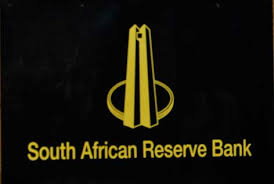South African Reserve Bank
The South African Reserve Bank (SARB) is the central bank of South Africa. It was established in 1921 after the Parliament of South Africa enacted the "Currency and Bank Act of 10 August 1920," as a direct result of the abnormal monetary and financial conditions which World War I had brought. The SARB was only the fourth central bank established outside the United Kingdom and Europe, the others being the USA, Japan and Java. Unlike the Bank of England, on which it is modeled, the SARB is privately owned.[1]
According to whistleblower Stephen Goodson (a former SARB director):
- 300 tonnes of gold valued at over R300 billion was stolen from the SARB, with the help of insiders as part of a bigger looting exercise valued at a massive R2.25 trillion.
- A third of our foreign currency reserves are looked after by a single bank: JP Morgan, a bank whose reputation for skulduggery goes sickeningly deep.
- 90% of our gold reserves are kept at the Bank of England.[2]
Contents
Functions of SARB
- Formulating and implementing monetary policy;
- Issuing banknotes and coin;
- Supervising the banking system;
- Ensuring the effective functioning of the national payment system (NPS);
- Managing official gold and foreign-exchange reserves;
- Acting as banker to the government;
- Administering the country's remaining exchange controls; and
- Acting as lender of last resort in exceptional circumstances.
Structure of SARB
Board of Directors
The South African Reserve Bank has a board of directors consisting of a Governor, three Deputy Governors, and eleven Directors. The Governor, and Deputy Governors are appointed for five year terms by the President of the Republic of South Africa in consultation with the Minister of Finance. Four of the directors are also appointed by the President of the Republic of South Africa for terms of three years. The remaining seven directors are appointed by the Shareholders of the Bank, also for a three year term.[3]
Ownership
The Reserve Bank is privately owned, with 2,000,000 issued shares. The only limitation on shareholding is that no single shareholder may own more than 10,000 shares individually. Currently there are more than 660 shareholders owning shares in the South African Reserve Bank.
Shareholders are entitled a dividend of not more than 10 South African cents per share per annum (the total maximum dividend is therefore 200,000 South African Rand or a maximum of 1,000 South African Rand for any individual shareholder), with the remaining profits being paid to the South African government.[4]
List of SARB Governors
- William Henry Clegg – December 1920 – December 1931
- Johannes Postmus – January 1932 – June 1945
- Michiel Hendrik de Kock – July 1945 – June 1962
- Gerhard Rissik – July 1962 – June 1967
- Theunis Willem de Jongh – July 1967 – December 1980
- Gerhardus Petrus Christiaan de Kock – January 1981 – August 1989
- Christian Lodewyk Stals – August 1989 – August 1999
- Tito Mboweni – August 1999 – November 2009
- Gill Marcus – November 2009 – November 2014
- Lesetja Kganyago – November 2014 – present
External links
References
- ↑ "South African Reserve Bank - Ownership".Page Module:Citation/CS1/styles.css must have content model "Sanitized CSS" for TemplateStyles (current model is "Scribunto").
- ↑ "Insiders Looted Gold Worth $200bn from South African Reserve Bank"
- ↑ "South Africa Reserve Bank - Board of Directors".Page Module:Citation/CS1/styles.css must have content model "Sanitized CSS" for TemplateStyles (current model is "Scribunto").
- ↑ "South Africa Reserve Bank - Reserve Bank Shares".Page Module:Citation/CS1/styles.css must have content model "Sanitized CSS" for TemplateStyles (current model is "Scribunto").
